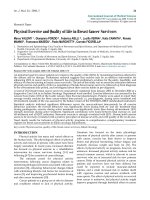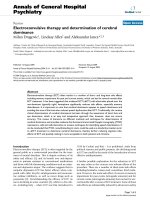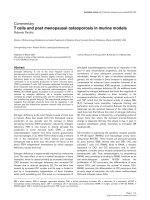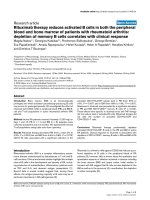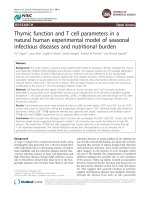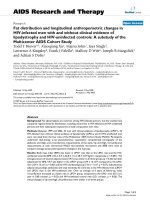Báo cáo y học: "Ozone Therapy and Hyperbaric Oxygen Treatment in Lung Injury in Septic Rats"
Bạn đang xem bản rút gọn của tài liệu. Xem và tải ngay bản đầy đủ của tài liệu tại đây (783.85 KB, 8 trang )
Int. J. Med. Sci. 2011, 8
48
I
I
n
n
t
t
e
e
r
r
n
n
a
a
t
t
i
i
o
o
n
n
a
a
l
l
J
J
o
o
u
u
r
r
n
n
a
a
l
l
o
o
f
f
M
M
e
e
d
d
i
i
c
c
a
a
l
l
S
S
c
c
i
i
e
e
n
n
c
c
e
e
s
s
2011; 8(1):48-55
© Ivyspring International Publisher. All rights reserved.
Research Paper
Ozone Therapy and Hyperbaric Oxygen Treatment in Lung Injury in Septic
Rats
Levent Yamanel
1
, Umit Kaldirim
1
, Yesim Oztas
2
, Omer Coskun
3
, Yavuz Poyrazoglu
4
, Murat Durusu
1
,
Tuncer Cayci
5
, A h m e t O z t u r k
6
, Seref Demirbas
6
, Mehmet Yasar
7
, Orhan Cinar
1
, Salim Kemal Tuncer
1
, Yusuf
Emrah Eyi
1
, Bulent Uysal
8
, Turgut Topal
8
, Sukru Oter
8
, Ahmet Korkmaz
8
1. Department of Emergency Medicine, Gulhane Military Medical Academy, Ankara, Turkey;
2. Department of Clinical Biochemistry, Hacettepe University, School of Medicine, Ankara, Turkey;
3. Department of Infectious Disease, Gulhane Military Medical Academy, Ankara, Turkey;
4. Department of General Surgery, Elazıg Military Hospital, Elazıg, Turkey;
5. Department of Clinical Biochemistry, Gulhane Military Medical Academy, Ankara, Turkey;
6. Department of Internal Medicine, Gulhane Military Medical Academy, Ankara, Turkey;
7. Department of Surgery, Gulhane Military Medical Academy, Ankara, Turkey;
8. Department of Physiology, Gulhane Military Medical Academy, Ankara, Turkey.
Corresponding author: Yesim Oztas, M.D., Department of Clinical Biochemistry, Hacettepe University, School of Medi-
cine, Ankara, Sıhhiye, 06100, Turkey. Phone: +90 312 3051652; Fax: +90 312 3245885; Email:
Received: 2010.10.28; Accepted: 2010.12.20; Published: 2011.01.03
Abstract
Various therapeutic protocols were used for the management of sepsis including hyperbaric
oxygen (HBO) therapy. It has been shown that ozone therapy (OT) reduced inflammation in
several entities and exhibits some similarity with HBO in regard to mechanisms of action. We
designed a study to evaluate the efficacy of OT in an experimental rat model of sepsis to
compare with HBO. Male Wistar rats were divided into sham, sepsis+cefepime, sep-
sis+cefepime+HBO, and sepsis+cefepime+OT groups. Sepsis was induced by an intraperi-
toneal injection of Escherichia coli; HBO was administered twice daily; OT was set as intra-
peritoneal injections once a day. The treatments were continued for 5 days after the induction
of sepsis. At the end of experiment, the lung tissues and blood samples were har v e s t e d f o r
biochemical and histological analysis. Myeloperoxidase activities and oxidative stress para-
meters, and serum proinflammatory cytokine levels, IL-1β and TNF-α, were found to be
ameliorated by the adjuvant use of HBO and OT in the lung tissue when compared with the
antibiotherapy only group. Histologic evaluation of the lung tissue samples confirmed the
biochemical outcome. Our data presented that both HBO and OT reduced inflammation and
injury in the septic rats’ lungs; a greater benefit was obtained for OT. The current study
d e m o n s t r a t e d t h a t t h e a d m i n i s t r a t i o n o f O T a s w e l l a s H B O a s a d j u v a n t t h e r a p y m a y s u p p o r t
antibiotherapy in protecting the lung against septic injury. HBO and OT reduced tissue
oxidative stress, regulated the systemic inflammatory response, and abated cellular infiltration
t o t h e l u n g d e m o n s t r a t e d b y f i n d i n g s o f M P O a c t i v i t y a n d h i s t o p a t h o l o g i c e x a m i n a t i o n . T h e s e
findings indicated that OT tended to be more effective than HBO, in particular regarding
serum IL-1β, lung GSH-Px and histologic outcome.
Key words: Sepsis; Escherichia coli; HBO; Ozone; Oxidant stress, Antioxidant.
INTRODUCTION
In spite of the advanced antibiotic therapies,
supportive treatments and technological facilities,
sepsis continues to be a clinical entity with high mor-
bidity and mortality [1]. The pathophysiology of sep-
Int. J. Med. Sci. 2011, 8
49
sis involves complex interactions between host organs
and the invading pathogen. Ultimately, tissue damage
and organ failure result from the adverse effects of
systemic activation of regulatory pathways [2-3].
Systemic elevations in the levels of proinflammatory
cytokines such as tumor necrosis factor (TNF-α) and
several interleukins (i.e., IL-1, IL-6 and IL-10) play a
chief role within this phenomenon [4]. The lung is the
organ which is affected initially, and sepsis leads to
severe injury in lung tissue [5]. It has been shown that
pericytes in lung tissue produce proinflammatory
cytokines in response to lipopolysaccharide (LPS) [6].
Hyperbaric oxygen (HBO) therapy is a well es-
tablished therapeutic approach increasing oxygen
concentration in all tissues; improving blood flow to
compromised organs; stimulating angiogenesis; in-
creasing antioxidant enzyme expression; and aiding
in the suppression of infections by enhancing white
blood cell action [7]. Previous experimental reports
have displayed that HBO therapy reduced oxidative
stress in liver and kidney tissues of septic rats [8-9].
Interception of the excessive proinflammatory cyto-
kines secretion, improvement of the physiological
vascular defense systems, and reduction in mortality
rates were demonstrated by various studies on HBO
administration in experimental septic shock models
[10-12].
Medical ozone therapy (OT) is a distinct thera-
peutic modality which depends on the administration
of a gas mixture comprising ozone and oxygen to
body fluids and cavities. The ozone/oxygen mixture
was reported to exhibit various effects on the immune
system, such as the modulation of phagocytic activity
[13]. Clinical and experimental studies have so far
shown that OT seems useful in inflamma-
tion-mediated diseases including infected wounds,
chronic skin ulcers, burns, and advanced ischemic
diseases [14]. It was also suggested that OT causes an
upregulation of antioxidant enzyme expression [15].
Recent reports demonstrated an obvious oxidative
stress reducing effect of OT in experimental rat mod-
els of necrotizing enterocolitis and caustic esophageal
burn injury [16-17]. Additionally, OT was shown to
prevent bacterial translocation to various tissues in-
cluding pancreas, peritoneum, liver, mesenteric
lymph nodes and cecum [18]. Interestingly, OT and
HBO seem to exhibit similar mechanisms of action to
some extent; i.e. stimulating antioxidant enzyme sys-
tems and enhancing oxygen delivery to tissues [19].
Although efficacy of OT in sepsis was tested in some
experimental settings, the benefits of OT have not
been clarified adequately [20-23].
Introduction of new strategies for treatment of
lung injury in sepsis is important to decrease morbid-
ity and mortality. This study was designed to define
the efficacy of OT as an adjuvant to antibiotherapy in
an experimental rat model of sepsis. In terms of their
similar mode of action, OT will also be compared to
HBO to evaluate possible differences among their
therapeutic effects.
MATERIALS AND METHODS
Animals
A total of 40 male Wistar albino rats (200-250 g)
were used for the study. All animal procedures were
approved by the Institutional Committee on the Care
and Use of Animals of Gulhane Military Medical
School (Issue; 2009/45). Before the experiment, ani-
mals had been fed standard rat chow and water ad
libitum and housed in cages with controlled temper-
ature and 12-hour light/dark cycle for at least 1 week.
Experimental groups
Antibiotherapy is an established protocol in the
therapy of sepsis. An untreated sepsis group was for-
bidden to ensure humane and proper care of experi-
mental animals by the local ethical committee. The
antibiotic (cefepime) alone treated group was as-
signed as control group to be compared with the
groups of adjuvant treatment modalities. Fifteen rats
were used in preliminary studies to set the sepsis
model and to achieve the appropriate cefepime do-
sage to reach the maximal survival rate needed for
5-days of experimental period. The onset of sepsis
was determined by clinical follow-u p , h e a r t r a t e c o u n t
and rectal temperature measurements. The other 40
rats were randomly divided into four groups con -
taining ten rats in each, sham, control, HBO, and OT
groups.
All treatments were started 10 hours after E.coli
inoculation; the sham animals had been injected phy-
siological saline (10 ml/kg) while the control group
received cefepime HCl (50 mg/kg) every 12 hours
intraperitoneally (i.p.) for five consecutive days; HBO
had been administered at 2.8 atm pressure with 100%
O
2
inhalation for 90 minutes twice daily and OT was
carried out by i.p. injections of the ozone/oxygen gas
mixture at an estimated ozone dose of 0.7 mg/kg
daily. Ozone was generated by the ozone generator
(Ozonosan Photonik 1014; Hansler GmbH, Nordring
8, Iffezheim, Germany), allowing control of the gas
flow rate and ozone concentration in real time by a
built-in UV spectrometer. The ozone flow rate was
kept constant at 3 L/min, representing a concentra-
tion of 60 mg/ml and a gas mixture of 97% oxygen +
3% ozone. Tygon polymer tubes and single-use sili-
con-treated polypropylene syringes (ozone resistant)
were used throughout the reaction to ensure con-
Int. J. Med. Sci. 2011, 8
50
tainment of ozone and consistency of concentrations.
The detailed experimental setup was demonstrated in
Table 1.
Table 1. Schedule for sepsis induction and timing of
treatments.
Study groups
Day of
experiment
Treatment
time
Sham Control HBO Ozone
Day 0 8 a.m. --- E.coli E.coli E.coli
6 p.m. Saline Cefepime Cefepime +
HBO
Cefepime +
OT
Day 1 6 a.m. Saline Cefepime Cefepime +
HBO
Cefepime
6 p.m. Saline Cefepime Cefepime +
HBO
Cefepime +
OT
Day 2 6 a.m. Saline Cefepime Cefepime +
HBO
Cefepime
6 p.m. Saline Cefepime Cefepime +
HBO
Cefepime +
OT
Day 3 6 a.m. Saline Cefepime Cefepime +
HBO
Cefepime
6 p.m. Saline Cefepime Cefepime +
HBO
Cefepime +
OT
Day 4 6 a.m. Saline Cefepime Cefepime +
HBO
Cefepime
6 p.m. Saline Cefepime Cefepime +
HBO
Cefepime +
OT
Day 5 6 a.m. Saline Cefepime Cefepime +
HBO
Cefepime
4 p.m. Sacrificing
Induction of sepsis
Rats in the Control, HBO and OT groups re-
ceived intraperitoneal inoculums of 1 ml saline con-
taining viable Escherichia (E.) coli cells (2.1x10
9
cf u) .
E.coli bacteria were isolated from the blood of a septic
patient who was hospitalized at Gulhane Military
Medical Academy Hospital (Ankara, Turkey). Sepsis
induction was started at the same hour (8 a.m.) in all
groups to prevent the possible effects of biological
rhythm.
Sample collection
At the end of 5
th
day of the study, general
anaesthesia was administered to immobilize the rats
[intraperitoneal ketamine (50 mg/kg) and dehydro-
benzoperidol (2 mg/kg)], blood samples for bio-
chemical evaluation was obtained from vena cava
inferior of the rats. Lung tissue samples were taken
and divided into two pieces, one of them was fixed in
10% formalin solution for histopathological evalua-
tion and the other was stored at -80°C to determine
antioxidant enzyme activity, tissue lipid peroxidation
and myeloperoxidase activity. Blood samples were
centrifuged at 2000g; serum samples were separated
and stored at -80°C until being used for cytokine as-
says.
Biochemical analysis
The frozen tissues were homogenized in lyses
buffer on an ice cube by using a homogenizator
(Heidolph Diax 900; Heidolph Elektro GmbH, Kel-
haim, Germany). The supernatant was used to assay
tissue parameters. Initially, the protein content of tis sue
homogenates and supernatants were measured by the
method of Lowry using bovine serum albumin as the
standard [24].
Levels of lipid peroxidation were measured by
the thiobarbituric acid (TBA) reaction according to the
method of Ohkawa where the reaction of thiobarbi-
turic acid (TBA) with malondialdehyde (MDA) gives
a color with a maximum absorbance at 535 nm [25].
The calculated MDA levels were expressed as
mmol/g-p r o t e in. Superoxide dismutase (SOD) activ-
ity was assayed by using a modified nitroblue tetra-
zolium (NBT) method as previously described [26].
Briefly, NBT was reduced to blue formazan by the
superoxide radical (·O
2
-
), which has a strong absor-
b a n c e a t 5 6 0 n m . O n e u n i t ( U ) o f S O D i s d e f i n e d a s t h e
amount of protein that inhibits the NBT redu c t i o n r a t e
by 50%. The estimated SOD activity was expressed as
units per gram protein. Glutathione peroxidase
(GSH-Px) activity was determined by using the pre-
viously described method in which GSH-Px activity
was coupled with the oxidation of NADPH by gluta-
thione reductase [27]. The oxidation of NADPH had
been observed spectrophotometrically at 340 nm, at
37ºC for 5 min. The GSH-Px activity was the slope of
the line obtained by plotting the amount of NADPH
oxidized versus time. GSH-Px activity was expressed
as U/gr protein.
Tissue myeloperoxidase (MPO) activities and
serum proinflammatory cytokine (TNF-α, IL-1β) le-
vels were evaluated by enzyme linked immunosor-
bent assay (ELISA) using commercially available kits
according to the manufacturer’s instructions (Bio-
source, Camarillo, CA, USA for cytokines; and USCN
Life Science Inc., Wuhan, China for MPO).
Histologic evaluation
Lung tissues were fixed in formalin for 24 h,
embedded in paraffin and cut into 4 µm sections. The
slides were stained with hematoxylin and eosin
(H&E) and examined under light microscope. Each
slide was evaluated by two expert investigators
blinded to the experiment groups. Lung injury was
evaluated based on a modified scoring system, in-
cluding four different categories, i.e. edema, hemorr-
hage, leukocyte infiltration and alveolar septal thick-
Int. J. Med. Sci. 2011, 8
51
ening, to grade the degree of lung injury in 10 fields
[28]. Each category was scored from 0 to 4; then the
total lung injury score was calculated by adding the
individual scores for each category and the scores for
each histological parameter were summed up to a
maximum score of 16.
Statistical analysis
Normality analyses were first performed using
the Shapiro-Wilk test in order to evaluate the distri-
bution of the data. Since presenting non-n ormal dis-
tribution, variance analyses of the entire results were
done by the Kruskal-Wallis test. Then, dual compari-
sons among groups were performed by the
Mann-Whitney U test. P values less than 0.05 were
considered significant. All analyses were performed
with the Statistical Package for the Social Sciences
(SPSS) software (version 11.0; SPSS Inc. Chicago, IL,
USA). Results were expressed as the median values
and their minimum-m a x i m u m r a n g e s .
RESULTS
During the study period, all animals were sur-
vived, and no complication was seen related to in-
duction of sepsis and treatment technique.
Biochemical analysis
Lung tissue MDA levels of the control group
were found to be significantly higher compared to all
other groups. The MDA values of HBO and OT were
not different significantly compared with sham ani-
mals.
Antioxidant enzyme values, SOD and GSH-Px,
were found to decrease in control animals. Compared
to control group, OT group had significantly higher
levels for both SOD and GSH-Px activity and HBO
group had only increased SOD activity. The GSH-Px
activity in OT group was significantly higher than
HBO group. The detailed outcome of these oxidative
stress parameters were presented in Figure 1.
Myeloperoxidase activity in the lung tissue of
control group was found to be increased significantly
compared to sham group indicating neutrophil infil-
tration into the lung tissue. Both OT and HBO ad-
ministration decreased the MPO activity; however,
the values were still significantly higher than that of
the sham group. Mean MPO activities in each group
were shown in Figure 2.
Serum T N F -α and IL-1β levels in the control
group were significantly higher than sham animals
indicating an inflammatory response related to sepsis.
OT was able to reverse these changes significantly,
whereas HBO reduced only TNF-α l e v e l . T h e o u t c o m e
of these proinflammatory parameters were presented
in Figure 3.
Figure 1. Oxidative stress indices in lung tissue. A: MDA levels were found to be significantly increased and antioxidant
enzymes depressed in the cefepime alone treated group. The addition of HBO or OT reversed these changes that MDA
l e v e l s r e t u r n e d n e a r t o s h a m v a l u e s . B a n d C : G S H -P x a n d S O D w e r e f o u n d t o b e d e c r e a s e d i n c o n t r o l a n i m a l s . T h e a c t i v i t y
o f G S H -P x w a s s i g n i f i c a n t l y m o r e i m p r o v e d w i t h O T t h a n H B O . O T g r o u p h a d s i g n i f i c a n t l y h i g h e r l e v e l s f o r b o t h S O D a n d
GSH-Px activity compared to control group. HBO group had increased SOD activity. GSH-P x a c t i v i t i e s o f O T g r o u p w e r e
significantly higher than HBO group.
a
p<0.05 vs. sham,
b
p<0.05 vs. control (cefepime),
c
p<0.05 vs. HBO groups.
Int. J. Med. Sci. 2011, 8
52
Figure 2. Lung tissue myeloperoxidase activity. The increased MPO activity in the control (cefepime) group was significantly
reduced when HBO or OT was used as adjuvant.
a
p<0.05 vs. sham,
b
p<0.05 vs. control (cefepime) groups.
Figure 3. Se ru m proinflammatory cytokine levels. The antibiotic only (control) treated group presented significantly higher
TNF-α a n d I L -1β v a l u e s t h a n t h e s h a m a n i m a l s . B o t h H B O a n d o z o n e t r e a t m e n t r e d u c e d t h e c y t o k i n e l e v e l s o f w h i c h I L -1β
was significantly more reduced with OT than HBO.
a
p<0.05 vs. sham,
b
p<0.05 vs. control (cefepime),
c
p<0.05 vs. HBO
groups.
Histologic evaluation
Histological examination revealed no evidence
of sepsis in the sham group, while all animals in the
control group showed severe degrees of sepsis with
marked edema, hemorrhage, leukocyte infiltration
and alveolar septal thickening. Degrees of hemorr-
hage, leukocyte infiltration, and alveolar septal
thickening in the HBO and OT groups, were much
l o w e r t h a n t h e c o n t r o l g r o u p . T h e d e c r e a s e i n t h e l u n g
injury score of OT was more evident than HBO group
being stastically significant. Representative photomi-
crographs of the study groups were presented in
Figure 4 and the detailed injury scores were shown in
Table 2.


